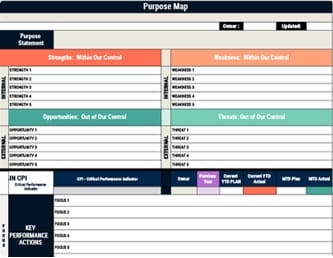You might think visual management is just charts on a wall, but you’ll use it to make performance visible, actionable, and owned by your team. You’ll align goals to clear KPIs, pick the right tools—dashboards, scorecards, or boards—and design metrics that reveal gaps instantly. You’ll set update rhythms, define escalation rules, and build feedback loops so improvements stick. Next, you’ll learn which tools fit each workflow and how to design for instant clarity.
Key Takeaways
- Align KPIs to strategic goals, define clear owners, and set red/yellow/green thresholds for instant status within 31 seconds.
- Use layered visual tools: boards and controls for operations, dashboards and scorecards for consolidated KPIs and trend insight.
- Stream real-time data, highlight deviations immediately, and attach notes or callouts to drive context and follow-through.
- Engage frontline teams in designing and maintaining displays to boost accountability, problem visibility, and adoption.
- Implement via a pilot: baseline metrics, training, weekly reviews, feedback loops, then scale with standardized practices.
Core Principles That Make Visual Management Work
Although visual tools can look simple, they work because they rest on five disciplined principles that translate data into decisions. Start by defining clear performance metrics and key performance indicators (KPIs) that tie directly to your organizational goals, then use visual management tools to make them visible and actionable.
Aim for immediate clarity within 31 seconds, so anyone can understand status, trends, and required actions without extra explanation.
Drive employee engagement by involving teams in designing and maintaining customized displays, because ownership strengthens accountability and data accuracy. Apply visual management practices that standardize formats, highlight exceptions, and signal priorities, so you reduce hesitation and enable timely responses.
Finally, institutionalize continuous improvement through regular reviews, adjusting measures and visuals as processes evolve, which sustains a culture of continuous improvement and keeps results aligned.
Types of Tools and When to Use Them
With your core principles in place, choose tools that match the decisions you need to make, the cadence of your work, and the level of interaction your team requires.
Use visual displays, like Kanban boards and production charts, when teams need real-time workflow status and simple performance tracking at the point of work.
Use visual displays—Kanban boards and production charts—for real-time workflow visibility and simple, point-of-work performance tracking.
Apply visual controls, such as Andon lights and standardized work charts, when you must guide behavior, enforce standards, and surface problems immediately.
Adopt dashboards when leaders need a consolidated view of key performance indicators (KPIs), trend lines, and alerts across processes.
Deploy performance scorecards to track objectives versus targets, support reviews, and drive continuous improvement conversations.
Select interactive displays for cross-functional huddles, rapid problem solving, and scenario testing, enabling effective visual management within broader Visual Management Systems.
Designing Metrics and Dashboards for Instant Clarity
Because instant clarity drives faster, better decisions, design metrics and dashboards that map directly to your goals, surface deviations in real time, and point to the next action without extra interpretation.
Start by selecting a small set of performance indicators tied to outcomes, not activities, then define red, yellow, and green thresholds that apply the 1-3-10 second rule for visual management.
Use Dashboards that stream real-time data, highlight trends, and label owners so accountability is obvious.
Drive engagement by adding brief notes or handwritten callouts that explain causes and next steps, which improves relatability and follow-through.
Enable customization so teams see only the metrics that matter, while preserving common definitions.
Review and refine weekly, compare targets to actuals, and document learnings to fuel continuous improvement and actionable insights.
Step-by-Step Implementation and Rollout
Start by running a brief readiness assessment that tests leadership commitment, cultural fit, and likely barriers. Then pick a pilot department or value stream with a tight scope, explicit success metrics, and a clear timeline so you can learn fast without broad disruption.
Define baseline performance tracking, set targets, and agree on how results will be reviewed, ensuring leaders model the behaviors you expect. Plan training sessions that explain visual management principles, demonstrate tools, and practice daily use, assigning clear ownership for updates and follow-ups.
Set baselines, targets, and review cadence. Train on visual management, assign ownership, and model desired leadership behaviors.
Run the pilot, collect feedback, and fix issues before a phased rollout, expanding to adjacent teams with standard work, playbooks, and support.
Build structured communication through tiered huddles to drive accountability, escalate risks quickly, and keep alignment with strategic goals, protecting engagement throughout.
Engaging Teams With Real-Time and Interactive Displays
Although technology can feel like the centerpiece, your real goal is to help teams see, interpret, and act on performance in the flow of work through real-time, interactive displays that make the right information unavoidable and actionable.
Use real-time data to surface deviations the moment they occur, then guide problem resolution with clear next steps. Build interactive displays that let people drill into performance metrics, filter by shift or asset, and confirm status quickly using the 1-3-10 second rule.
Deploy visual tools like dashboards and scorecards so KPIs are always visible, enabling fast recognition of normal versus abnormal conditions.
Involve operators and supervisors in the design and upkeep, which drives accountability and engaging teams. Promote collaboration during huddles, tie insights to performance tracking, and reinforce continuous improvement through simple, consistent routines.
Reviewing, Refining, and Scaling Your System
Even as your visual management tools gain traction, you need a disciplined cadence to review performance, refine what isn’t working, and scale what is.
Set a monthly and quarterly rhythm that tests assumptions, compares performance metrics to targets, and ties decisions to organizational goals.
Use real-time data to spot bottlenecks quickly, then prioritize refining processes that remove delays and clarify ownership, improving accountability and communication across teams.
Incorporate employee feedback during structured retrospectives, since frontline insights reveal gaps and practical fixes.
When results are consistent, standardize and document scaling practices, enabling repeatable adoption that lifts operational efficiency across departments.
- A wall of trend charts, showing huddle attendance rising week by week.
- A dashboard pulsing red, triggering a quick root-cause huddle.
- A playbook page, detailing a proven escalation path.
- A rollout map, highlighting departments adopting the standard.
Frequently Asked Questions
What Is the 1 3 10 Rule in Visual Management?
The 1-3-10 rule means you should grasp normal status in one second, spot a problem in three seconds, and know the required action within ten seconds.
You achieve this by using clear visuals, consistent color codes, concise labels, and simple charts that highlight thresholds and trends.
You place displays where work happens, standardize formats across teams, and train people to read them quickly, so decisions speed up and accountability stays visible.
What Are Visual Management Systems?
Visual management systems are your organization’s map and compass, where walls and screens become signposts.
You use visual cues—dashboards, charts, and boards—to display KPIs, targets, and status, so everyone sees performance at a glance.
You integrate live data to surface problems quickly, then assign owners and actions.
You standardize symbols and update displays regularly, which streamlines communication, reduces search time, clarifies priorities, and fosters accountability and continuous improvement across teams.
What Are the 4 Guiding Principles of Visual Management?
The four guiding principles are standardization, problem identification, action-oriented responses, and employee engagement with continuous improvement.
You standardize processes so information stays consistent and comparable. You expose problems quickly with clear, visual cues, then define owners, deadlines, and countermeasures to drive accountability.
You involve employees in designing and maintaining visuals, building ownership and practicality.
Finally, you review, learn, and refine visuals regularly, aligning metrics and workflows with evolving goals and performance gaps.
What Are the Three Tools Used for Visual Management?
The three tools you’ll use most are Kanban boards, dashboards, and performance boards.
You’ll map work on Kanban boards to balance demand and capacity, exposing bottlenecks and flow issues.
You’ll monitor dashboards to track real-time KPIs, spot deviations early, and trigger corrective actions.
You’ll run performance boards to align goals, visualize progress, and drive accountability during standups.
Together, these tools make work visible, accelerate decisions, and support continuous improvement.
Conclusion
You’re ready to build a visual management system that turns goals into daily actions, because you’ve learned what to track, how to design dashboards, and how to engage teams with real-time feedback. Treat your system like a well-lit runway: clear metrics guide decisions, timely reviews correct course, and shared visuals keep everyone aligned. Start small, standardize what works, and iterate, since consistent use, disciplined updates, and transparent accountability will drive results and scale performance across your organization.


